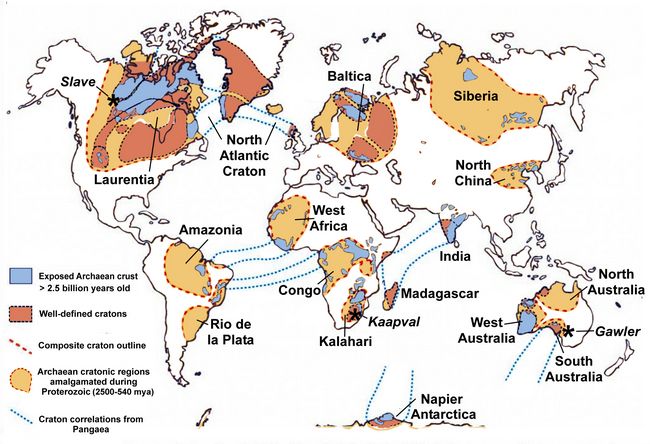Athena Review Image Archive ™
Map of Cratons

Map of Cratonic regions around the Earth (after Pearson and Wittig 2008).
Craton (from Greek kratos, "strength") is ancient bedrock that forms an old, stable part of the continental lithosphere, in contrast to more unstable, geologically active regions on a continent.
The Lithosphere is a rigid layer on the earth’s surface which includes the crust and the uppermost mantle, a rigid outer layer which is underlain by the asthenosphere, the weaker, hotter, and deeper part of the upper mantle.This layer of lithospheric mantle can be 2 to 3 times thicker than the crust above.
Over time the more rigid lithosphere breaks up into tectonic plates, while the underlying aestheosphere is more viscous and plastic. This results in movement of the tectonic plates around the surface of the earth, a process now understood as continental drift, first formulated by Alfred Wegener in 1912. The concept of the lithosphere itself was introduced by Joseph Barrell (1914) and developed by R.A. Daly (1940). The two essential concepts of a rigid lithosphere over a plastic underlayer, and of continental drift, were synthesized in the theory of plate tectonics which emerged in the 1960s.and 70s.
Cratons have deep lithospheric roots, extending up to several hundred km into the Earth's mantle. Cratons are usually found in the interiors of tectonic plates, after surviving various cycles of the merging and splitting of continents.
Cratons
are made up of ancient crystalline basement rock, which either outcrops
as a shield, or is covered by platforms of younger sedimentary rock.
Every continent has cratonic areas, notably the core of North America,
Scandinavia, Siberia, India and most of Australia. They may be covered
by a thin layer of sediment, but often they expose ‘basement’ rocks
such as gneiss.
The
first large cratonic landmasses formed during the Archean eon (4.5-2.0
billion years ago). Much of that rock has been reformed during the
subsequent Proterozoic eon (2.5 billion- 540 million years ago), with
only 5 to 40 percent of the present continental crust formed during the
Archean.
Examples of cratons are the Slave Craton in Canada, the Kaapvaal Craton in South Africa, and the Gawler Craton in South Australia. Cratons are areas where the earliest fossils of Precambrian microbes have been found, often in the form of stromatolites or mat-like layers of the residues of bacterial colonies.
References
Bleeker, W., and B.W. Davis 2004. What is a craton? American Geophysical Union, Spring Meeting 2004, abstract id. T41C-01
Pearson, D. and N. Wittig. 2008. Formation of Archaean continental lithosphere and its diamonds: the root of the problem. Journal of the Geological Society, 165 (5), 895-914
Copyright © 1996-2020 Rust Family Foundation (All Rights Reserved).